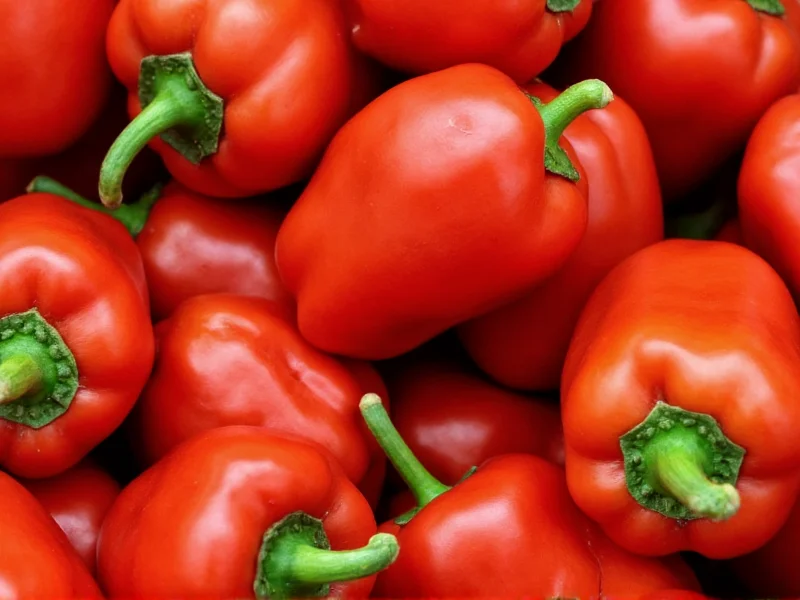Understanding which peppers create this vibrant spice unlocks the secrets behind its diverse culinary applications. While all paprika originates from Capsicum annuum species, regional growing conditions and specific cultivars produce dramatically different end products. This comprehensive guide explores the botanical origins, regional variations, and processing methods that transform simple peppers into one of the world's most versatile spices.
The Botanical Foundation: Capsicum annuum Varieties
Despite paprika's global presence, all authentic paprika begins with Capsicum annuum peppers. This species encompasses both sweet and hot varieties, but paprika production predominantly utilizes sweet cultivars with minimal capsaicin content. The key distinguishing factors among paprika-producing peppers include:
- Fruit shape and size (blocky vs. elongated)
- Color development at maturity (ranging from bright orange to deep red)
- Water content and flesh thickness
- Natural sugar concentration
- Presence of specific carotenoids that create color
Unlike chili powder which often combines multiple pepper varieties, traditional paprika maintains strict adherence to specific regional cultivars. This botanical purity preserves distinctive flavor profiles that define regional paprika styles.
Regional Pepper Varieties and Their Paprika Profiles
The most significant differences in paprika stem from the specific pepper varieties cultivated in different regions. Each area has developed unique cultivars optimized for local growing conditions and traditional processing methods.
| Region | Primary Pepper Varieties | Processing Method | Flavor Profile |
|---|---|---|---|
| Hungary | Kurri, Szegedi, Kalóca | Sun-dried, stone-ground | Sweet, fruity, complex earthiness |
| Spain | Ñora, Padrón, Jarra | Smoked over oak wood | Deeply smoky, moderately sweet |
| California | Sweet Bell hybrids | Mechanically dried | Mild, one-dimensional sweetness |
| Serbia | NovΌsadski | Air-dried, traditional grinding | Balanced sweet-heat, floral notes |
Hungarian Paprika Pepper Varieties
Hungary's volcanic soil and continental climate create ideal conditions for growing the specific Capsicum annuum cultivars used in authentic Hungarian paprika. The most prized varieties include:
- Kurri: Small, conical peppers with exceptionally high carotenoid content producing vibrant red color
- Szegedi: Larger, blocky peppers with balanced sweetness and subtle heat
- Kalóca: Elongated peppers with complex flavor notes and moderate heat
Hungarian regulations require that genuine Hungarian paprika contain only domestically grown peppers of approved varieties. This strict standard preserves the distinctive flavor profiles that have made Hungarian paprika the gold standard worldwide. The country's six designated paprika-producing regions each produce slightly different flavor profiles based on microclimates and soil composition.
Spanish Paprika Pepper Varieties
Spain's unique contribution to paprika comes from the smoked variety known as pimentón. The primary peppers used include:
- Ñora peppers: Small, round peppers with thick walls ideal for smoking
- Padrón peppers: Though famous as table peppers, specific mature varieties are used for paprika
- Jarra peppers: Elongated varieties with deep red color when mature
The smoking process, traditionally over oak wood in brick chambers called secaderos, transforms these sweet peppers into the distinctive pimentón de la Vera. The duration of smoking creates the three classifications: dulce (sweet), agridulce (bittersweet), and picante (spicy). This smoking technique represents one of the most significant processing differences between Spanish and Hungarian paprika production.
From Pepper to Powder: The Transformation Process
The journey from fresh pepper to finished paprika involves several critical steps that preserve flavor and color compounds:
- Harvesting: Peppers are picked at peak ripeness when carotenoid levels are highest
- Drying: Traditional sun-drying (Hungary) vs. smoking (Spain) vs. mechanical drying (commercial production)
- Seed and membrane removal: These parts contain most capsaicin, affecting heat level
- Grinding: Stone grinding preserves flavor compounds better than high-speed mechanical grinding
- Aging: Some premium paprikas age for months to develop complex flavors
The drying method significantly impacts the final product's chemical composition. Sun-dried Hungarian paprika preserves more vitamin C and carotenoids, while smoked Spanish paprika develops guaiacol and other phenolic compounds that create its distinctive smoky flavor. Temperature control during drying is critical - exceeding 40°C (104°F) degrades color compounds and diminishes flavor quality.
Selecting Quality Paprika Based on Pepper Origins
Understanding the pepper varieties behind paprika helps consumers make informed choices. When evaluating paprika options, consider these factors related to the source peppers:
- Color intensity: Deep red indicates high carotenoid content from properly ripened peppers
- Aroma: Fresh paprika should have a sweet, pepper-forward scent without mustiness
- Regional designation: Look for protected designations like «Paprika Hévíz» (Hungary) or «Pimentón de la Vera» (Spain)
- Harvest date: Freshness matters as paprika loses potency within 6-12 months
Authentic Hungarian paprika often displays a six-tier quality scale on packaging, ranging from Extra Special (deepest color, sweetest) to Hot (with added cayenne). Spanish pimentón clearly indicates whether it's dulce, agridulce, or picante. These classifications directly reflect the pepper varieties and processing methods used.
Common Misconceptions About Paprika Peppers
Several misconceptions persist about the peppers used for paprika production:
- Misconception: All paprika comes from the same pepper variety
Reality: Different regional styles use distinct cultivars optimized for local conditions - Misconception: Paprika is just ground bell peppers
Reality: While bell peppers can be used, traditional paprika comes from specific non-bell C. annuum varieties - Misconception: Hot paprika contains different species of peppers
Reality: Heat variation comes from the same pepper varieties with different seed/membrane ratios
Understanding these distinctions helps appreciate why artisanal paprika commands premium prices compared to generic supermarket versions. The specific pepper varieties, combined with traditional processing methods, create flavor compounds that cannot be replicated through industrial shortcuts.











 浙公网安备
33010002000092号
浙公网安备
33010002000092号 浙B2-20120091-4
浙B2-20120091-4